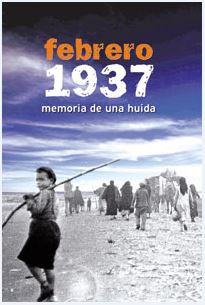One nefarious day in February 78 years ago, over half the population of Malaga fled to the countryside, down the long and difficult seaside road to Almeria that was their only escape route. Behind them, the invading troops of General Franco, already crowing victory. And on all sides, Italian, German and Franquist naval ships and war planes showering bombs down on the fleeing and defenceless civilians, in the forgotten Massacre of the Road to Almeria.
Most of this human column of fleeing refugees, over 150,000 souls, was made up of women, children and families, who had had nothing to do with the war. As happens in all wars, it’s the politicians and military men who make the decision to attack, and the civilian population – women, children and ordinary men just trying to make a living doing whatever they can – who pay the high price.
The Spanish Civil War (1936 – 1939) was, like all wars, complicated and difficult to explain. Most people supported the Republicans. However, the opposition, led by Francisco Franco, enjoyed the support of the Fascist troops of Germany and Italy, and it wasn’t long before they began to conquer the entire country.
Wherever the Franquists went, people fled. Like all invaders, Franco’s troops were notorious for their savagery and barbarism. They looted, stole, raped, murdered, tortured and took whatever they wanted.
So it wasn’t surprising that as soon as the inhabitants of Malaga discovered that these invaders were at their doorstep, they took to the road and fled.
In those days the only unoccupied route out of Malaga was along the dangerous and sinuous road to Almeria. There was little place to hide along the road: it wound its way between the sheer cliffs that fell down towards the sea on one side, and the high mountains on the other. The distance from Malaga to Almeria: 219 km.
That ill-fated Sunday morning, people woke up to the sounds of the Franquist troops surrounding the city, grabbed their things and ran. Those who could climbed into cars, trucks or onto donkeys and mules. The rest had to make their way on foot.
16-year-old Ana María Jiménez woke up in her home in the Capuchinos neighbourhood, looked out the window and saw Francisco Franco’s troops on the mountains overlooking the city, with their cannons and their flags and their muskets.
Her family, like most other families living in Malaga, loaded their belongings onto a truck heading out of town and started on their way. In Rincon de la Victoria, on the outskirts of Malaga, they ran out of gasoline and continued the rest of the way on foot.
“I didn’t understand much about the war at that time,” recalls José Martos, who was only six back then, “but I had it clear that we were running from the Fascists.”
The journey lasted a week. Along the way, as the naval ships drew up close to the shore and began pelting them with bombs and bullets, people started to fall. The Italian and German aviation added their two cents’ worth by riddling the straggling survivors with more bombs.
There was no reason for doing this, other than the cruelty, sadism and taste for innocent blood of the militants who ordered and carried out these attacks.
The people fleeing along the road weren’t Franco’s enemies. They were just families trying to make a living during hard times. They were carpenters and farmers and cooks and schoolteachers. Mothers with babies and little children.
A woman stops to feed her baby, surrounded by dead people, on the long road from Malaga to Almeria
The man who ordered this cowardly attack against the defenceless citizens, Gonzalo Queipo de Llano, explains it thus: “Those masses of people were fleeing, they were getting away. So I thought, why not make them run a little harder?”
The people who survived did so by hiding in holes, ducking down on the ground, rolling behind stones or anything that could shelter them.
Along the way, Ana María and the other refugee children met families who had lost loved ones. Parents burying children in holes in the ground. Entire families lying dead together.
The group found respite about halfway down the road: at Motril, the International Brigade succeeded in halting the enemy attacks and the people were free to continue their journey without death raining down from the sky. However, by then most were so exhausted they could hardly walk.
Suddenly, salvation surged up out of nowhere. Like a dashing white knight in shining armour at the head of a flaming cavalry, the Canadian doctor Norman Bethune arrived with a party of trucks to drive them the rest of the way to Almeria.
Norman Bethune was a Canadian doctor working the Republican frontlines bringing medical aid during the Spanish Civil War. He was in Valencia when he received news of the forced exodus from Malaga, and he hurried to Malaga as quickly as he could.
Norman Bethune with his ambulance
Over and over again, the trucks took off overflowing with people, then returned for more. Norman Bethune himself rode in a vehicle which he had converted into an ambulance, where he attended to the ill and the wounded.
The odyssey didn’t end in Almeria for most of the families on this trail. When they arrived in that remote city, most made their way out on ships and trains and travelled to Barcelona. Some of these families remained in Barcelona for the duration of the war while others journeyed into exile, returning only after the war had ended.
Photo credits: Norman Bethune
For more information:
El camino de los olvidados (Diario Sur)
La matanza de la carretera de Almería (El País)
La matanza de la carretera de Almería (Málaga en Blanco y Negro)
If you enjoyed this post (I really hope you do!), maybe you will also like:
Abandoned Sugar Factory at El Tarajal, Malaga
The Old Provincial Prison of Malaga




